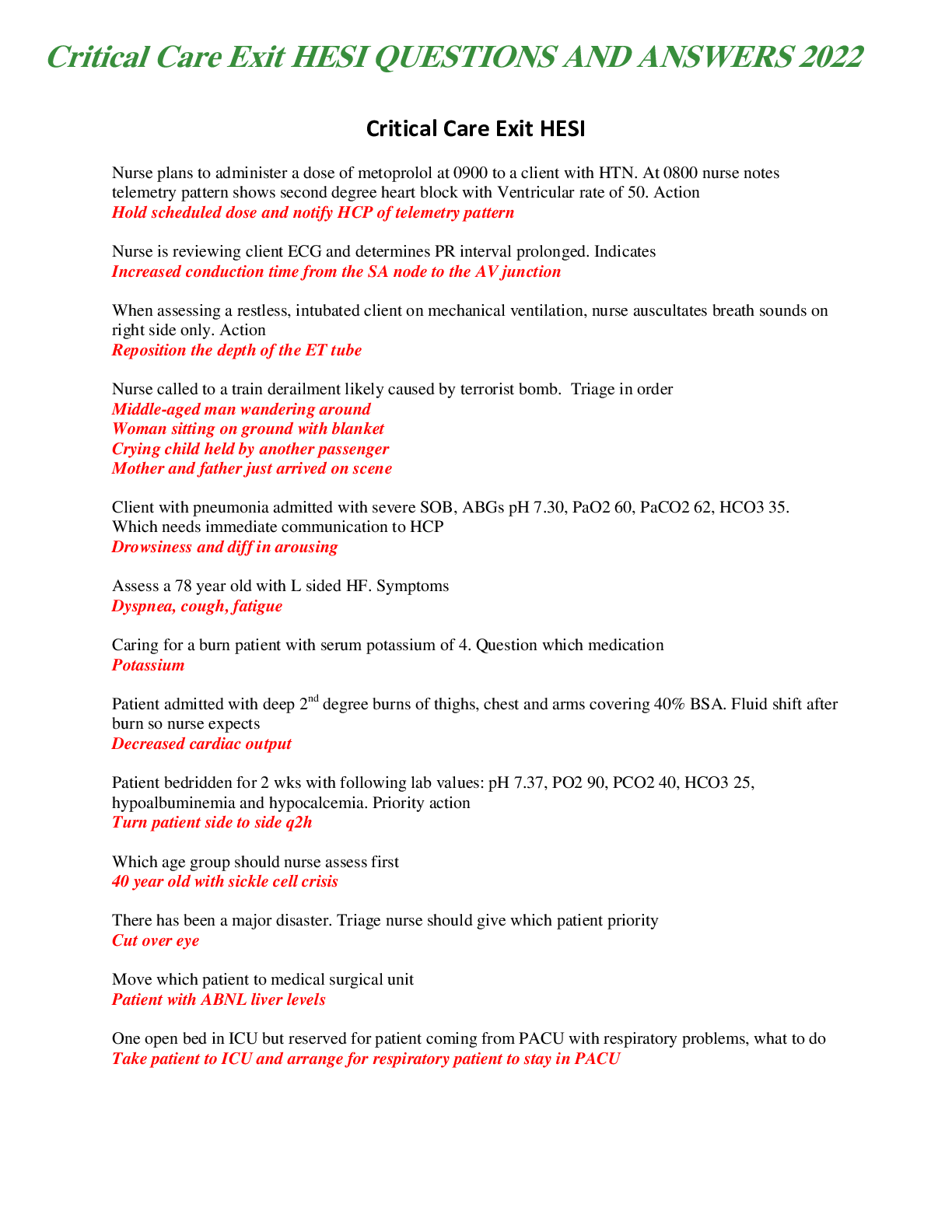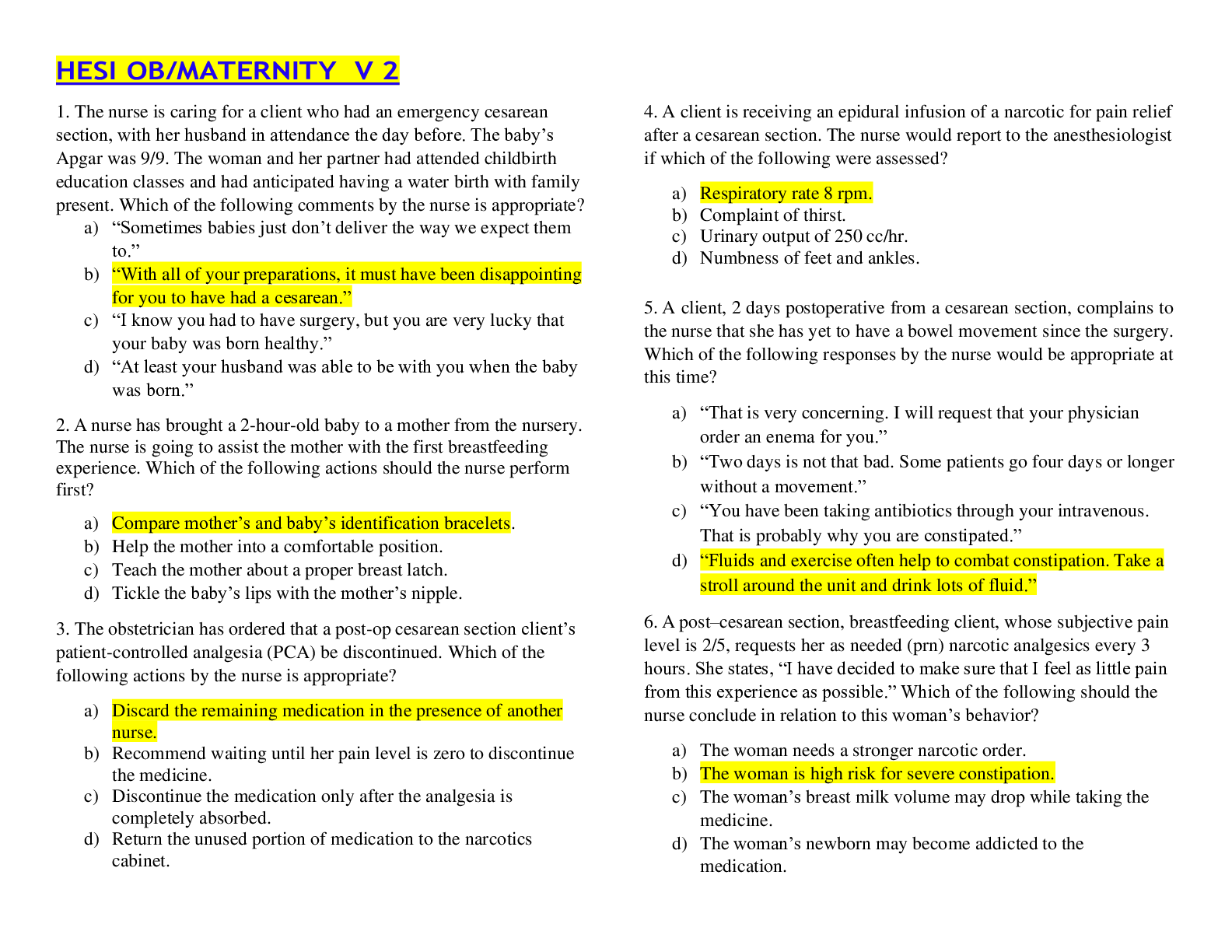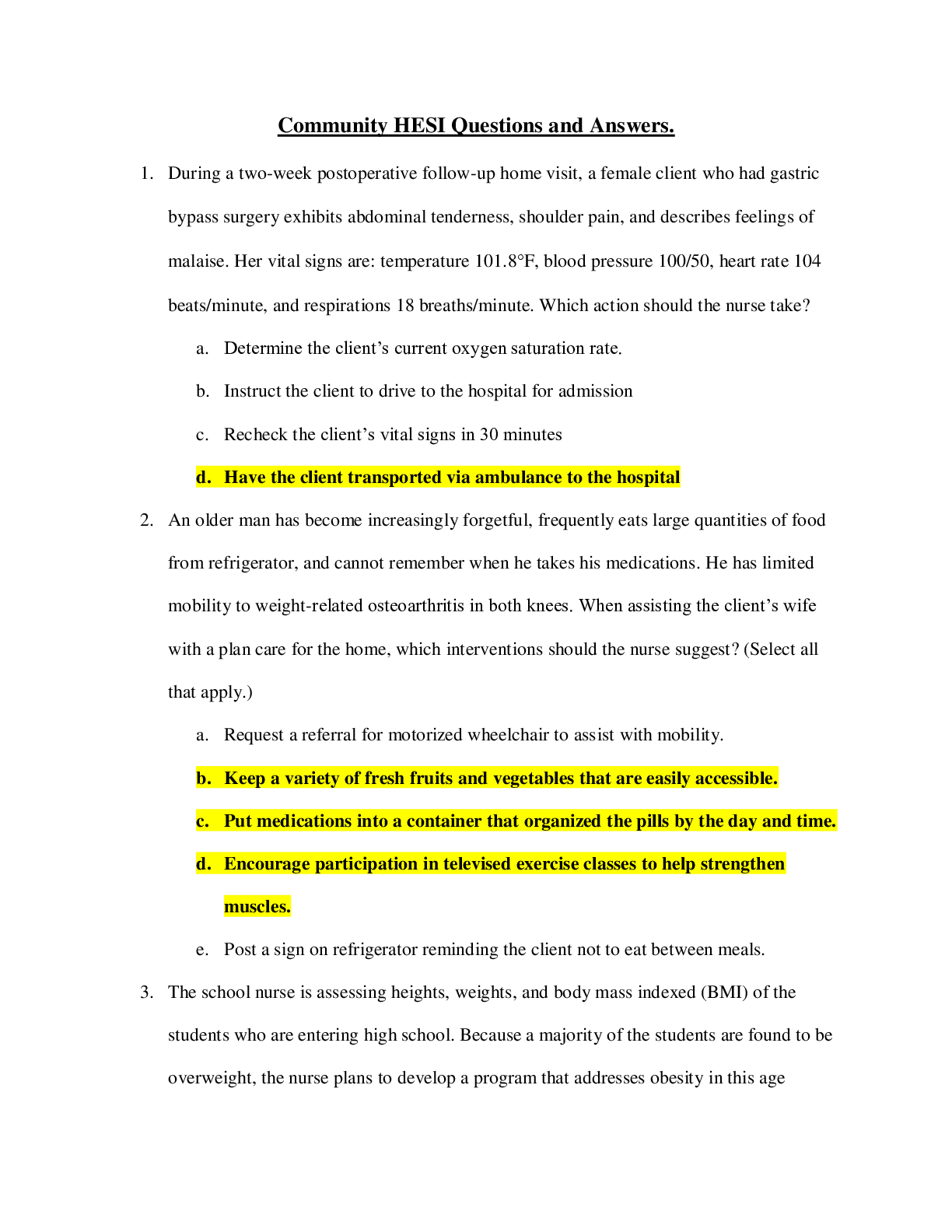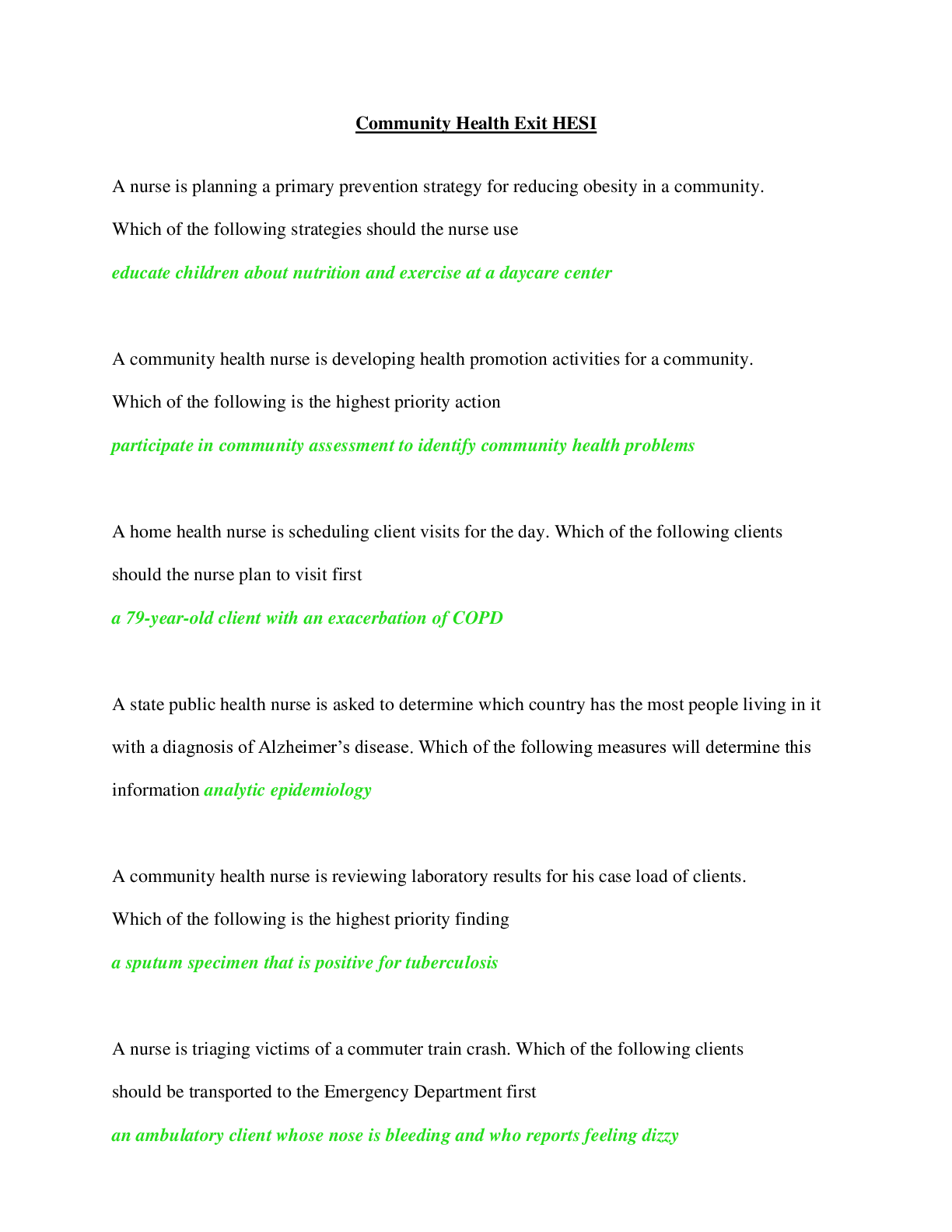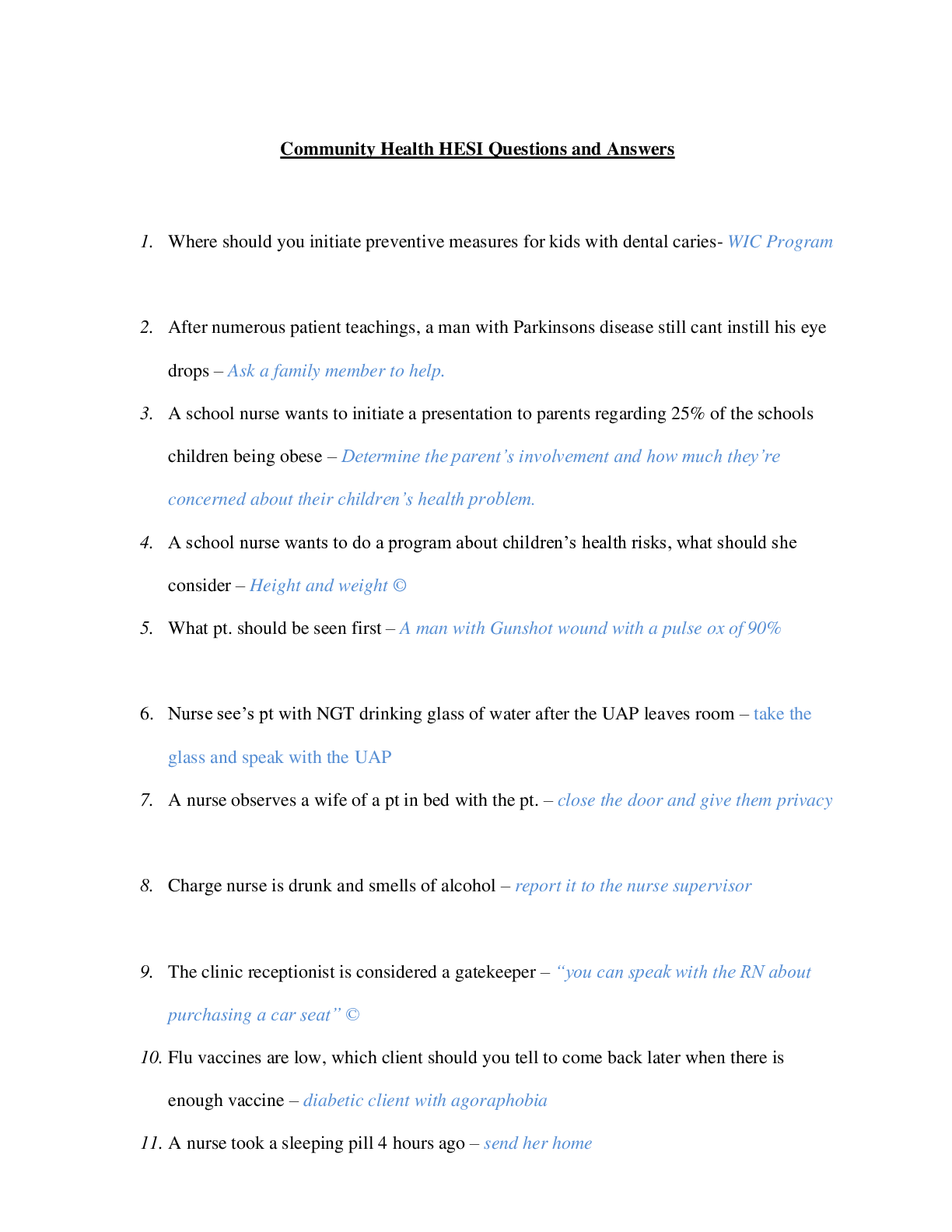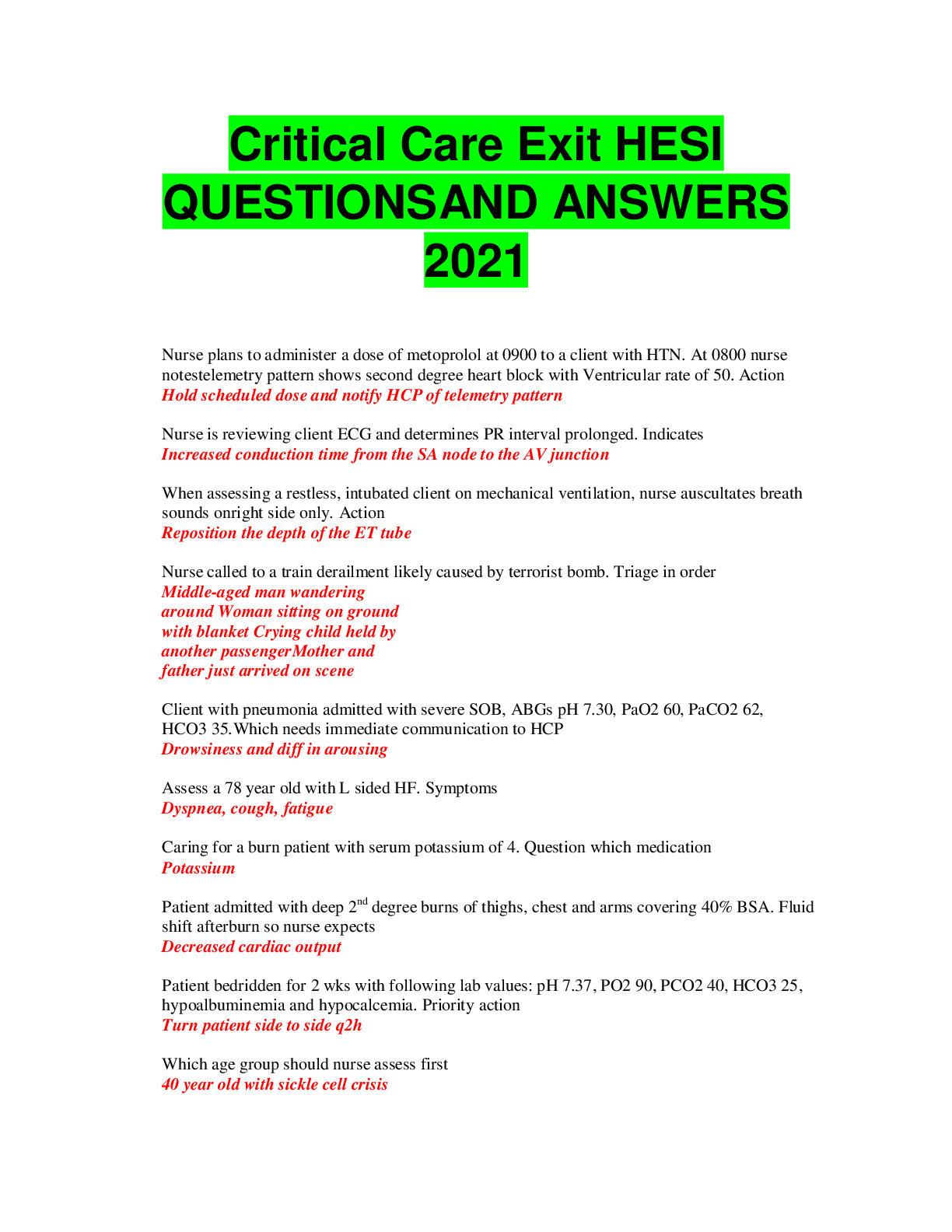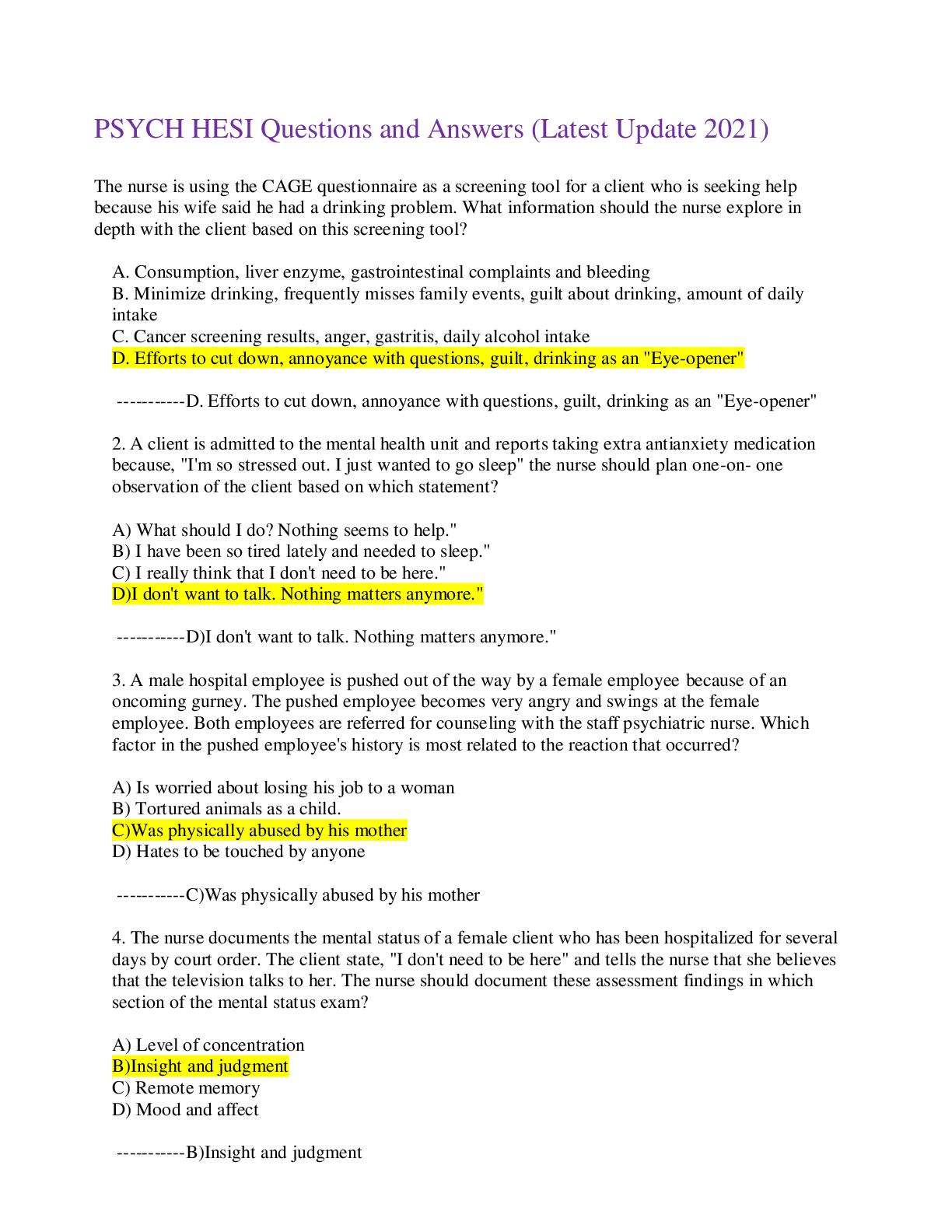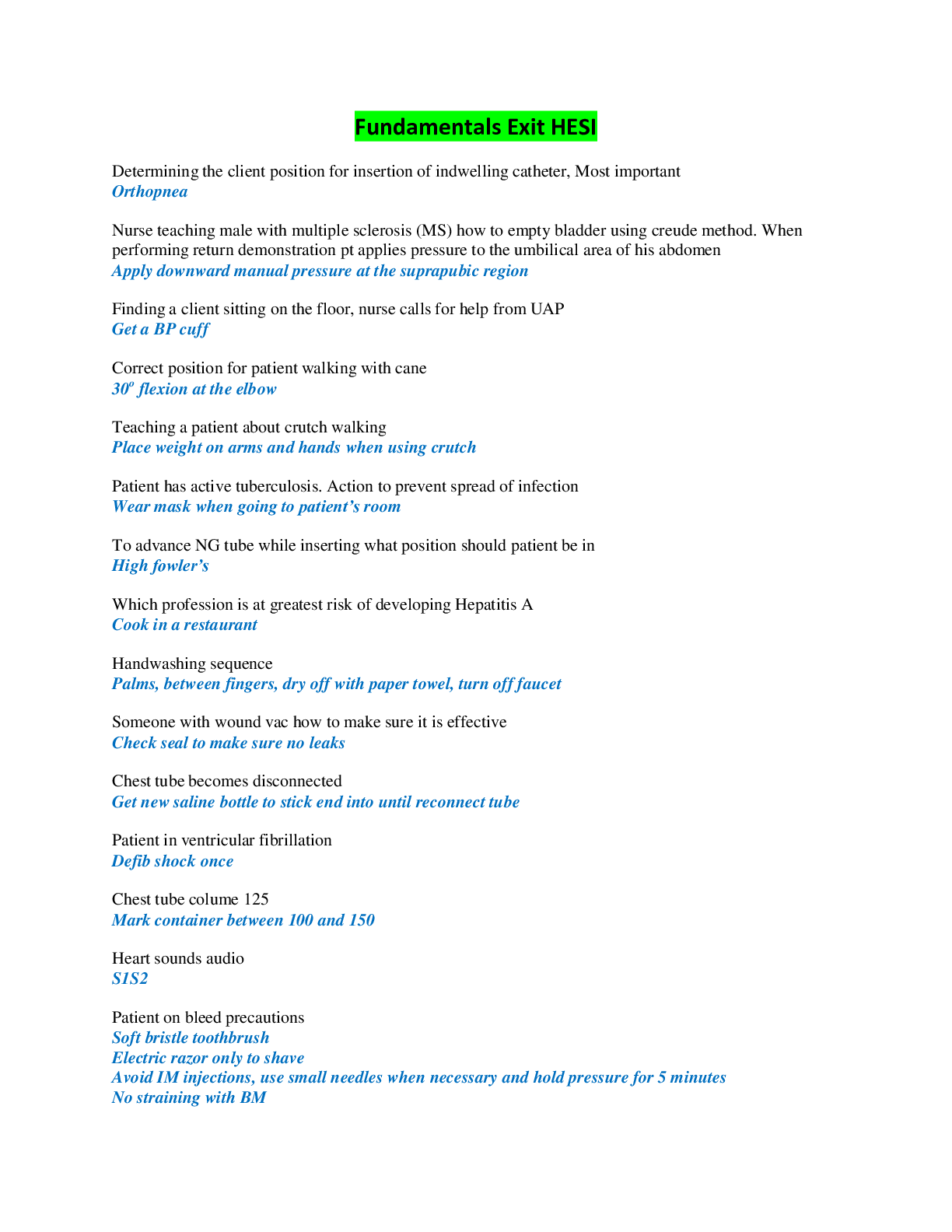HEALTH ASSESSMENT HESI QUESTIONS AND ANSWERS (GRADED A)
Document Content and Description Below
A patient is being assessed for range of joint movement. The nurse asks him to move his arm in toward the center of his body. This movement is called: adduction A patient tells the nurse that sh... e is having a hard time bringing her hand to her mouth when she eats or tries to brush her teeth. The nurse knows that for her to move her hand to her mouth, she must perform which movement? flexion The functional units of the musculoskeletal system are the: joints Fibrous bands running directly from one bone to another that strengthen the joint and help prevent movement in undesirable directions are called: ligaments The articulation of the mandible and the temporal bone is known as the: temporomandibular joint The nurse is checking the range of motion in a patient's knee and knows that the knee is capable of which movement(s)? flexion and extension We have an expert-written solution to this problem! A woman who is 8 months pregnant comments that she has noticed a change in posture and is having lower back pain. The nurse tells her that during pregnancy women have a posture shift to compensate for the enlarging fetus. This shift in posture is known as: lordosis An 85-year-old patient comments during his annual physical that he seems to be getting shorter as he ages. The nurse should explain that decreased height occurs with aging because: of the shortening of the vertebral column A patient has been diagnosed with osteoporosis and asks the nurse, "What is osteoporosis?" The nurse explains to the patient that osteoporosis is defined as: loss of bone density The nurse is teaching a class on osteoporosis prevention to a group of postmenopausal women. Which of these actions is the best way to prevent or delay bone loss in this group? Taking calcium and vitamin D supplements The nurse is assessing a patient for carpal tunnel syndrome. The patient complains of pain when the nurse taps on her median nerve at the wrist. This patient is positive for: Tinel's sign The nurse is assessing a patient for carpal tunnel syndrome and is about to perform Phalen's test. The first thing the nurse does is: asks the patient to hold his wrists back to back while flexing the wrists 90 degrees. A patient is complaining of pain in his joints that is worse in the morning, is better after he has moved around for awhile, and then gets worse again if he sits for long periods of time. The nurse should assess for other signs of what problem? rheumatoid arthritis We have an expert-written solution to this problem! A patient states, "I can hear a crunching or grating sound when I kneel." He also states that it is "very difficult to get out of bed in the morning because of stiffness and pain in my joints." The nurse should assess for signs of what problem? crepitation We have an expert-written solution to this problem! The nurse has completed the musculoskeletal examination of a patient's knee and has found a positive bulge sign. The nurse interprets this finding to indicate: swelling from fluid in the suprapatellar pouch A young swimmer comes to the sports clinic complaining of a very sore shoulder. He was running at the pool, slipped on some wet concrete, and tried to catch himself with his outstretched hand. He landed on his outstretched hand and has not been able to move his shoulder since then. The nurse suspects: a dislocated shoulder A patient's annual physical examination reveals a lateral curvature of the thoracic and lumbar segments of his spine; however, this curvature disappears with forward bending. The nurse knows that this abnormality of the spine is called: functional scoliosis When assessing muscle strength, the nurse observes that a patient has complete range of motion against gravity with full resistance. What grade should the nurse record using a 0-5 point scale? 5 We have an expert-written solution to this problem! The nurse should use which test to check for large amounts of fluid around the patella? ballottement When performing a musculoskeletal assessment, the nurse knows that the correct approach for the examination should be: proximal to distal The nurse is assessing the joints of a woman who has stated, "I have a long family history of arthritis, and my joints hurt." The nurse suspects that she has osteoarthritis. Which of these are symptoms of osteoarthritis? asymmetric joint involvement, pain with motion of affected joints, and affected joints are swollen with hard, bony protuberances A 22-year-old woman comes to the clinic because of a severe sunburn and states, "I was just out in the sun for a couple of minutes." The nurse begins a medication review with her, paying special attention to which medication class? tetracyclines for acne A woman is leaving on a trip to Hawaii and has come in for a checkup. During the examination the nurse notices that she is diabetic and takes oral hypoglycemic agents. The patient needs to be concerned about which possible effect of her medications? the importance of sunscreen and avoiding direct sunlight The nurse keeps in mind that a thorough skin assessment is very important because the skin holds information about a person's: circulatory status A patient comes in for a physical, and she complains of "freezing to death" while waiting for her examination. The nurse notes that her skin is pale and cool and attributes this finding to: peripheral vasoconstriction A patient tells the nurse that he has noticed that one of his moles has started to burn and bleed. When assessing his skin, the nurse would pay special attention to the danger signs for pigmented lesions and would be concerned with which additional finding? color variation An elderly woman is brought to the emergency department after being found lying on the kitchen floor for 2 days, and she is extremely dehydrated. What would the nurse expect to see upon examination? dry mucous membranes and cracked lips A 42-year-old female patient complains that she has noticed several small, slightly raised, bright red dots on her chest. On examination, the nurse expects that the spots are probably: senile angiomas A 65-year-old man with emphysema and bronchitis has come to the clinic for a follow up appointment. On assessment, the nurse might expect to see which assessment finding? clubbing of the nails The nurse notices that a patient has a solid elevated, circumscribed lesion that is less than 1 cm in diameter. When documenting this finding, the nurse would report this as a: papule A patient has had a "terrible itch" for several months that he has been scratching continuously. On examination, the nurse might expect to find: lichenification A physician has diagnosed a patient with purpura. After leaving the room, a nursing student asks the nurse what the physician saw that led to that diagnosis. The nurse should say, "The physician is referring to: those tiny little areas of hemorrhage that are less than 2 mm round, discrete, and dark red in color A patient's mother has noticed that her son, who has been to a new babysitter, has some blisters and scabs on his face and buttocks. On examination, the nurse notices moist, thin-roofed vesicles with a thin erythematous base and suspects: impetigo The nurse is assessing the skin of a patient who has AIDS and notices multiple patch-like lesions on the temple and beard area that are faint pink in color. The nurse recognizes these lesions as Kaposi's sarcoma The nurse has discovered decreased skin turgor in a patient and knows that this is an expected finding on which of these conditions? severe dehydration While performing an assessment of a 65-year-old man with a history of hypertension and coronary artery disease, the nurse notices the presence of pitting edema in the lower legs bilaterally. The skin is puffy and tight but of normal color. There is no increased redness or tenderness over his lower legs, and the peripheral pulses are equal and strong. In this situation, the nurse suspects that the likely cause of the edema would be: heart failure Which skin lesion is defined as tiny punctuate hemorrhages, 1-3 mm, round and discrete, dark red, purple, or brown in color? petechiae Which skin lesion is also known as friction blisters? vesicle Which skin lesion is defined as solid, elevated, hard or soft, larger than 1 cm? nodule A patient has been admitted to a hospital after the staff in the nursing home noticed a pressure ulcer in his sacral area. The nurse examines the pressure ulcer and determines that it is a stage II ulcer. Which of these findings are characteristic of a stage II pressure ulcer? partial thickness skin erosion with loss of epidermis or dermis, and open blister areas have a red-pink wound bed A patient admitted to the clinic complains of itchy mosquito bites. Which finding would the nurse expect to see upon assessment of the skin? wheal In performing a breast examination, the nurse knows that it is especially important to examine the upper outer quadrant of the breast. The reason for this is that the upper outer quadrant is: the location of most breast tumors The nurse is palpating a female patient's breasts during an examination. Which of these positions is most likely to make significant lumps more distinct during breast palpation? supine with arms raised over her head A patient states during the interview that she noticed a new lump in the shower a few days ago. It was on her left breast near her axilla. The nurse should plan to palpate which breast first? the unaffected breast When is the best time to perform breast self-examination? 4-7 days after the first day of the menstrual period While examining a 75-year-old woman, the nurse notices that the skin over her right breast is thickened and the hair follicles are exaggerated. This condition is known as: peau d'orange The nurse is assessing the breasts of a 68-year-old woman and discovers a mass in the upper outer quadrant of the left breast. When assessing the mass, the nurse keeps in mind that characteristics of a cancerous mass include which of the following? nontender mass, hard, dense, and immobile, irregular poorly defined border The nurse is examining a 62-year-old man and notes that he has gynecomastia bilaterally. The nurse should explore his history for which related conditions? obesity hyperthyroidism liver disease history of alcohol abuse During a health history, a 22-year-old woman asks, "Can I get that vaccine for HPV? I have genital warts and I'd like them to go away!" What is the nurse's best response? "The vaccine cannot protect you if you already have an HPV infection." During a speculum inspection of the vagina, the nurse would expect to see what at the end of the vaginal canal? cervix A male patient reports polyuria, straining to urinate, weak stream during urination, a sensation of incomplete emptying, and nocturia. These may be signs of: enlarged prostate The nurse is percussing the seventh right intercostal space at the midclavicular line over the liver. Which sound should the nurse expect to hear? dullness We have an expert-written solution to this problem! Which structure is located in the left lower quadrant of the abdomen? sigmoid colon A patient is having difficulty swallowing medications and food. The nurse would document that this patient has: dysphagia The nurse suspects that a patient has a distended bladder. How should the nurse assess for this condition? percuss and palpate the midline area above the suprapubic bone We have an expert-written solution to this problem! The nurse is aware that one change that may occur in the GI system of an aging adult is: decreased gastric acid secretion A patient's abdomen is bulging and stretched in appearance. The nurse should document this finding as: protuberant The nurse is describing a scaphoid abdomen. To the horizontal plane, a scaphoid contour of the abdomen depicts a ____ profile. concave A patient has hypoactive bowel sounds. The nurse knows that a potential cause of hypoactive bowel sounds is: peritonitis The nurse is watching a new graduate nurse perform auscultation of a patient's abdomen. Which statement by the new graduate shows a correct understanding of the reason auscultation precedes percussion and palpation of the abdomen? It prevents distortion of bowel sounds that might occur after percussion and palpation. The nurse is listening to bowel sounds. Which of these statements is true of bowel sounds? They are usually high-pitched, gurgling, irregular sounds. The physician comments that a patient has abdominal borborygmi. The nurse knows that this term refers to: hyperactive bowel sounds During an abdominal assessment, which percussion sound is normal? a tympanic percussion note in the umbilical region An older patient has been diagnosed with pernicious anemia. The nurse knows that this condition could be related to: decreased gastric acid secretion A nurse notices that a patient has ascites, which indicates the presence of: fluid The nurse notices that a patient has had a black, tarry stool and recalls that a possible cause would be: GI bleeding During an abdominal assessment, the nurse elicits tenderness on light palpation in the RLQ. This could indicate a disorder of which structure? appendix The nurse is assessing the abdomen of an aging adult. Which of these statements regarding the aging adult and abdominal assessment is true? the abdominal musculature is thinner A patient is suspected of having inflammation of the gallbladder, or cholecystitis. The nurse should conduct which of these techniques to assess for this condition? Murphy's sign The nurse is reviewing the assessment of an aortic aneurysm. Which of these statements is true regarding an aortic aneurysm? a pulsating mass is usually present Which percussion finding would the nurse expect to find in a patient with ascites? dullness Which of the following describes a hernia? A hernia is a loop of bowel protruding through a weak spot in the abdominal muscles. During report, the student nurse hears that a patient has "hepatomegaly" and recognizes that this term refers to: an enlarged liver. During an abdominal assessment, the nurse tests for a fluid wave. A positive fluid wave test occurs with: ascites The nurse suspects that a patient has appendicitis. Which of these procedures are appropriate for use when assessing for appendicitis or a perforated appendix? Blumberg's sign and iliopsoas muscle test After completing an initial assessment on a patient, the nurse has charted that his respirations are eupneic and his pulse is 58. This type of data would be: objective [Show More]
Last updated: 7 months ago
Preview 1 out of 16 pages
Instant download
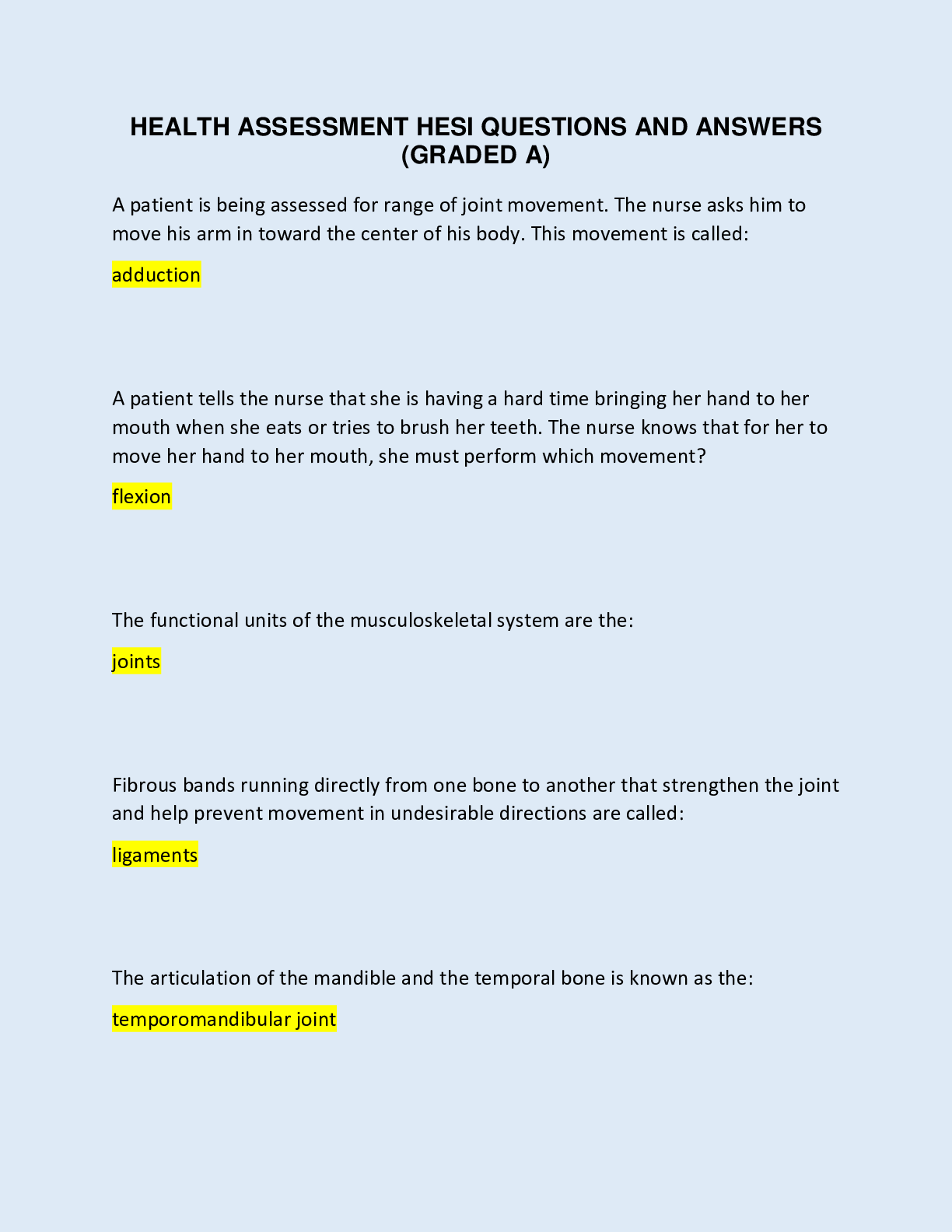
Instant download
Also available in bundle (1)

HESI Health Assessment Exams and Study Materials PACKAGE DEAL (100% Guaranteed Pass
HESI Health Assessment Exams and Study Materials PACKAGE DEAL (100% Guaranteed Pass
By A+ Solutions 7 months ago
$20.5
11
Reviews( 0 )
Document information
Connected school, study & course
About the document
Uploaded On
Oct 09, 2023
Number of pages
16
Written in
Additional information
This document has been written for:
Uploaded
Oct 09, 2023
Downloads
0
Views
60


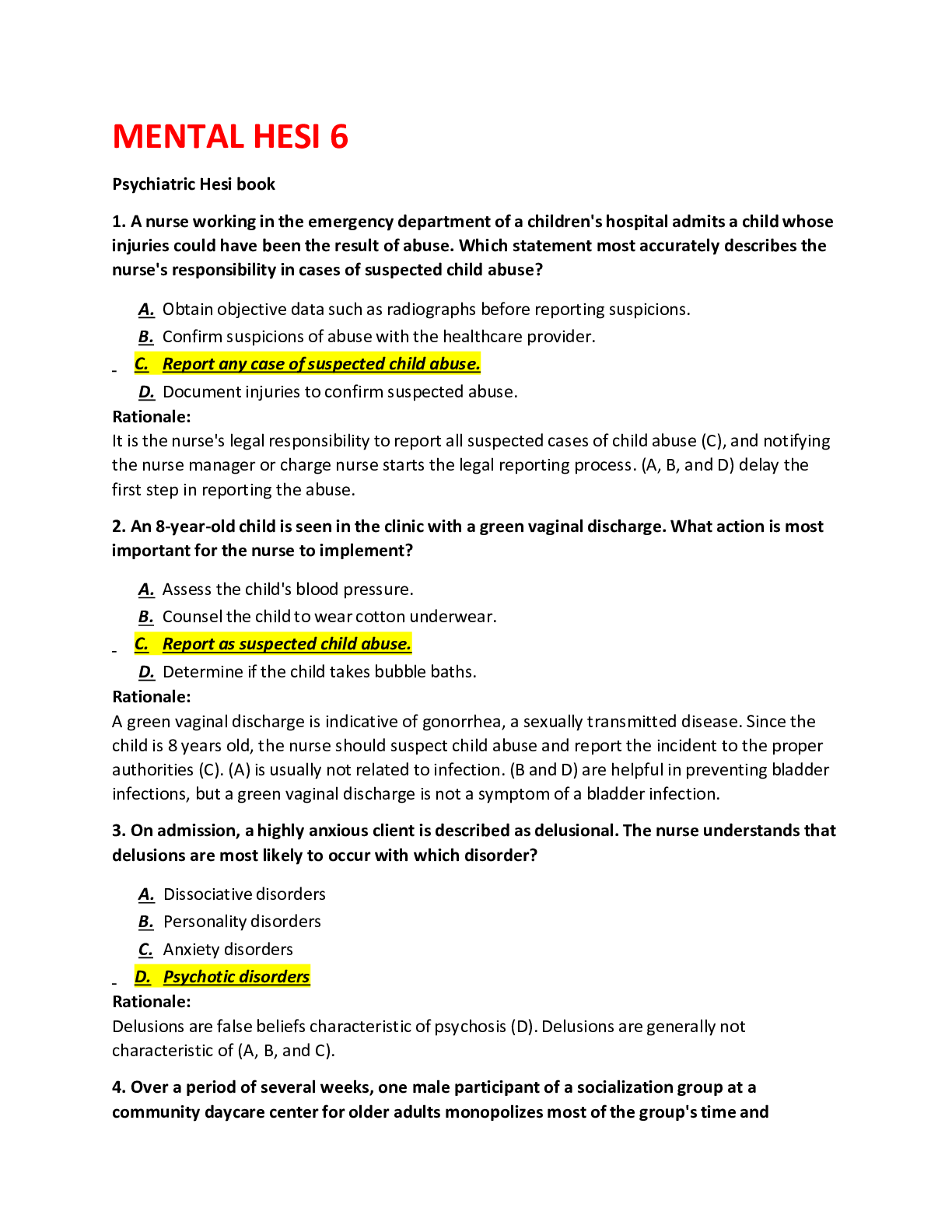
.png)


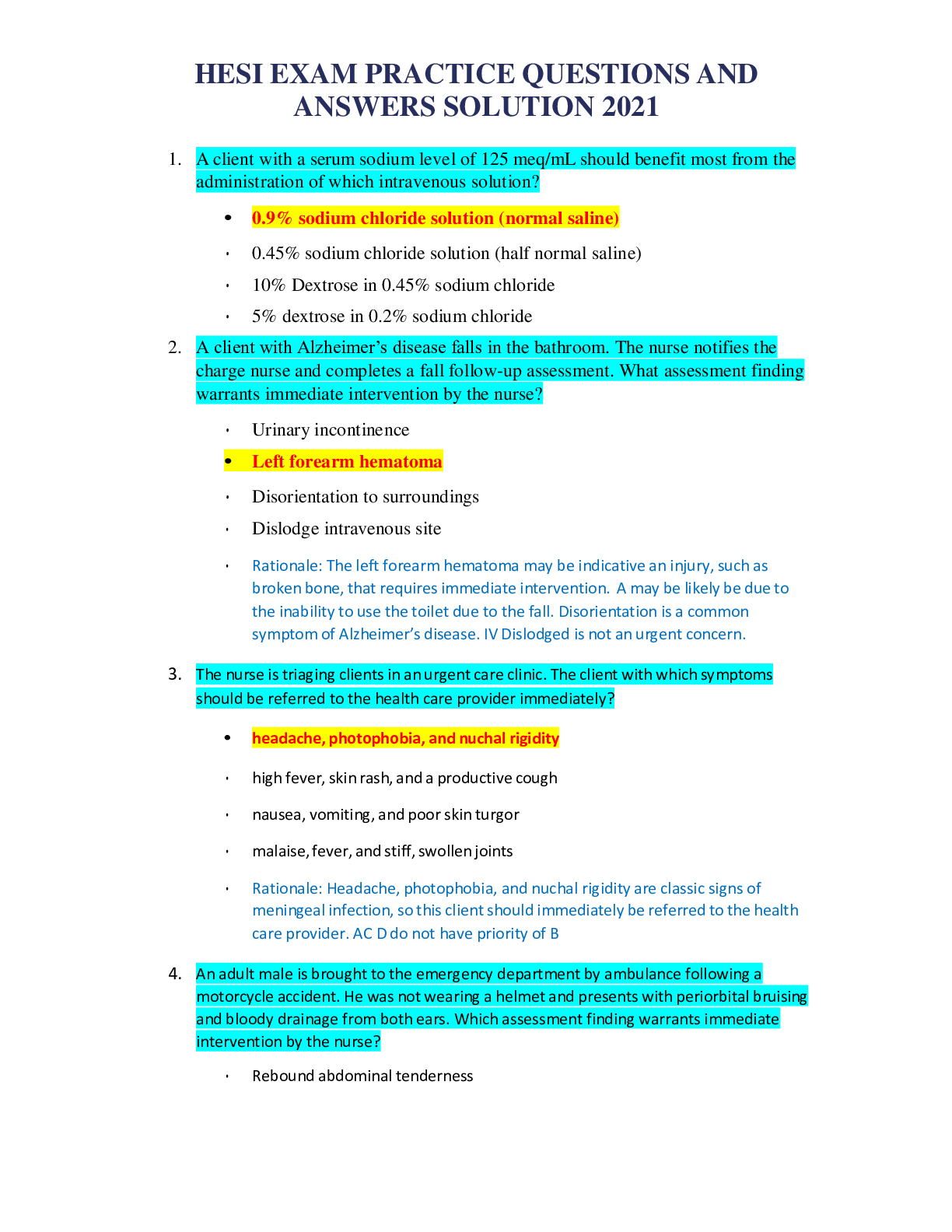
.png)
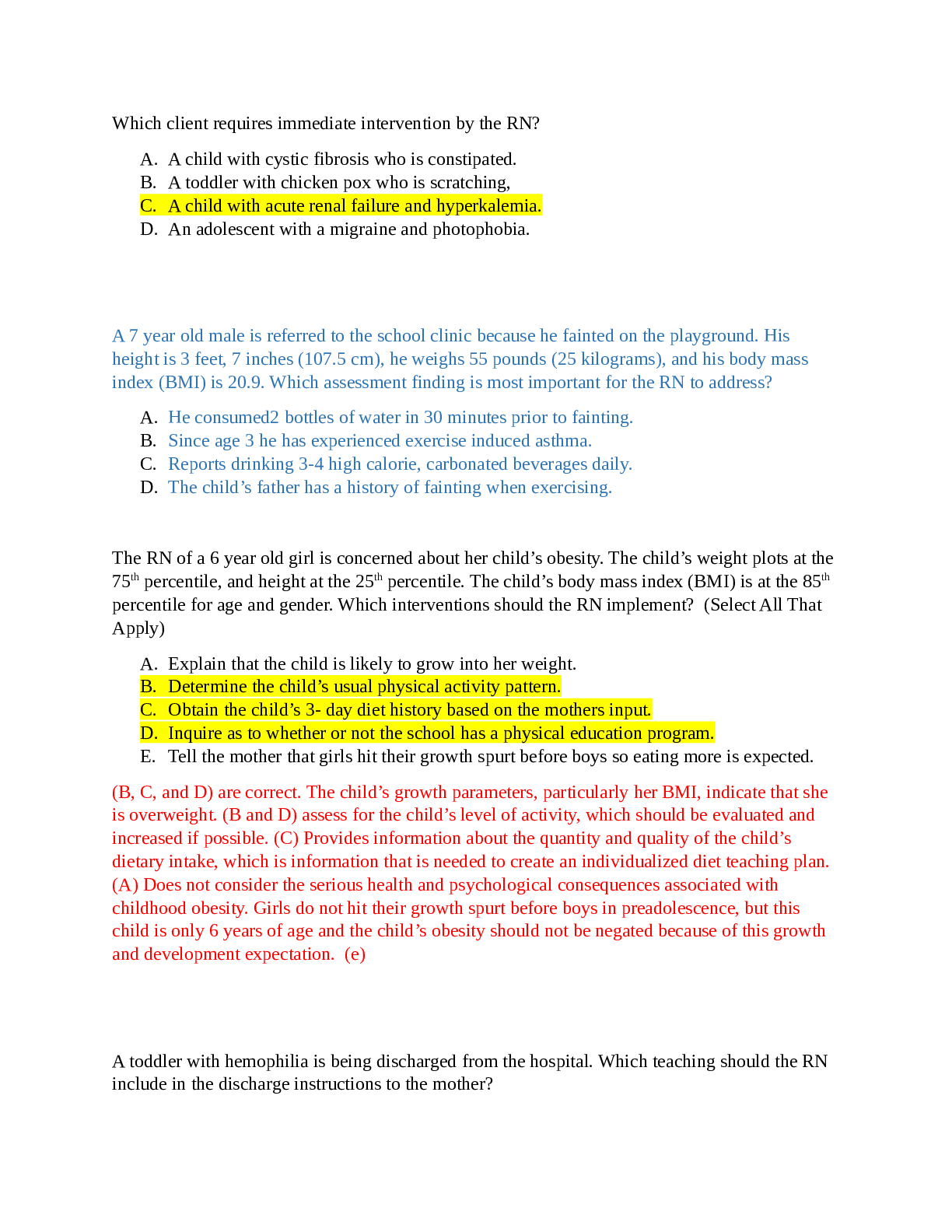



.png)
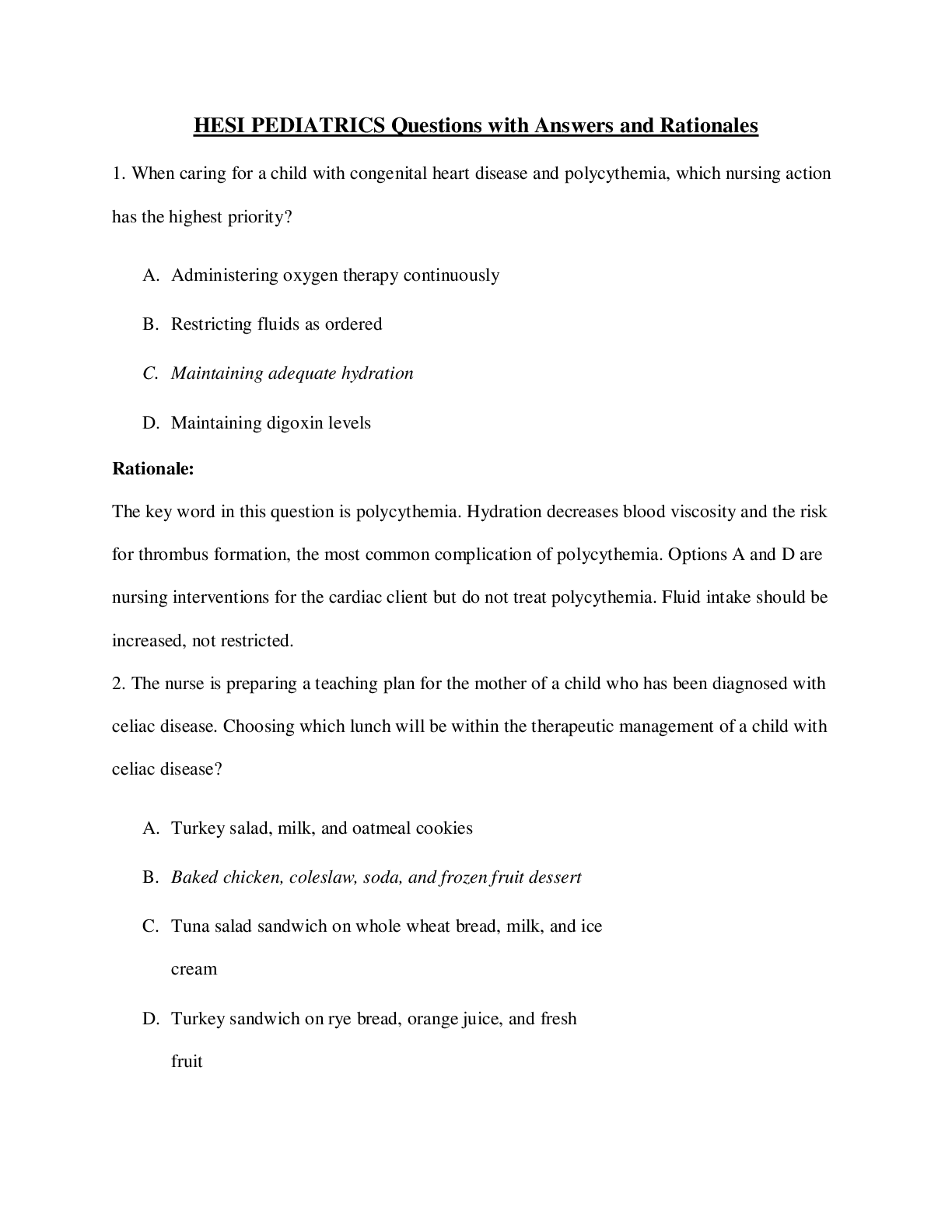
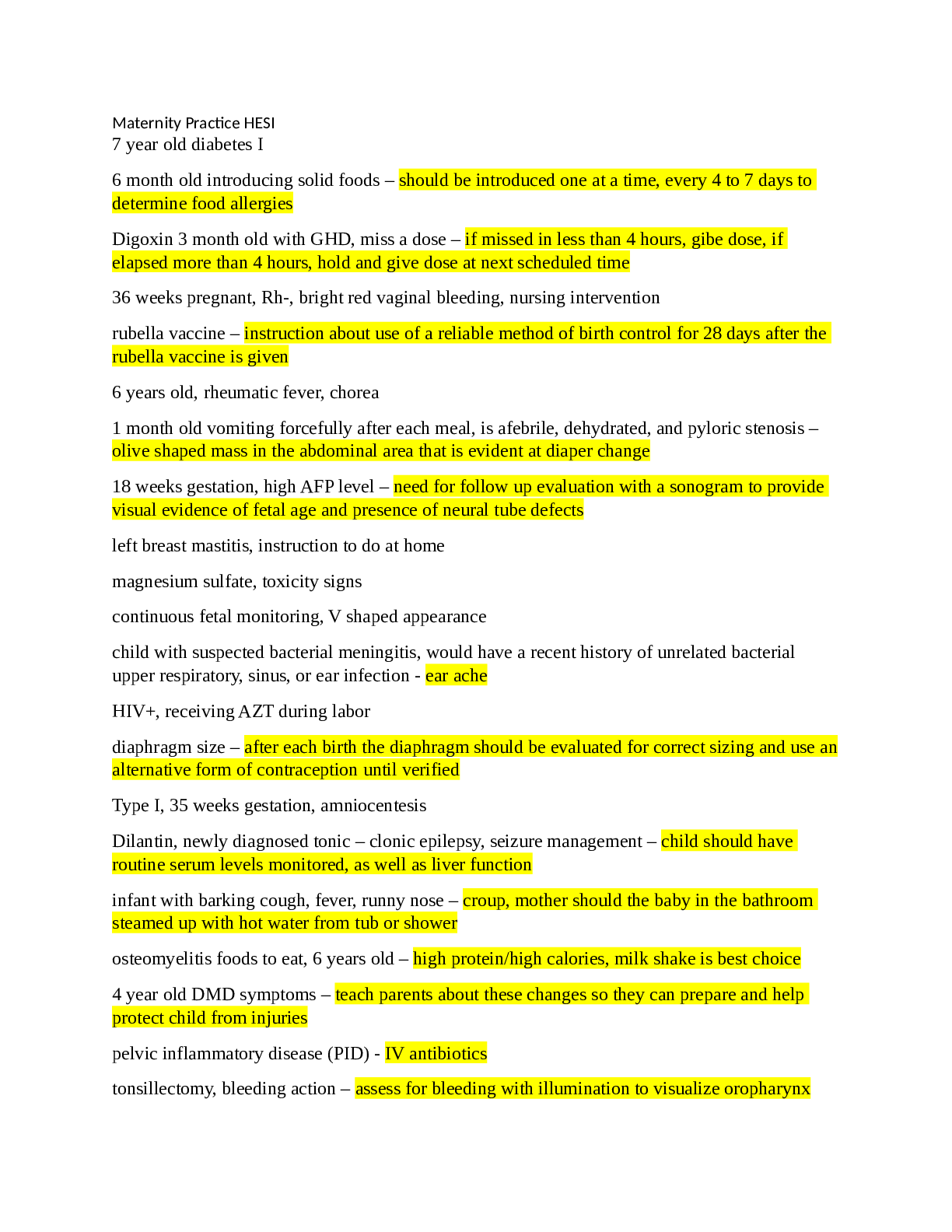


.png)
